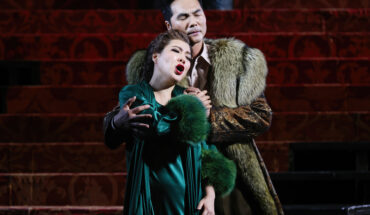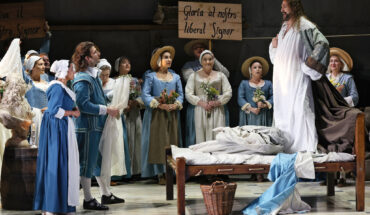Check This Out.
What a joy and a privilege it is to bask in the glorious artistry and elite athleticism that is The Australian Ballet! Despite feeling inadequate in the comparatively meagre portion of talent I have been granted by nature and nurture, envy cannot overwhelm the awe and gratitude that sweep over me in the presence of sheer beauty and strength.
The Australian Ballet’s latest triple bill program 20:21 is modern ballet pushed to the physical extremes. It showcases two works by the most celebrated creative giants of the 20th century and a fresh vision, which is fast becoming a new sensation, of the 21st century. For anyone who, like me, is used to and fond of the classical 19th century European ballets – Swan Lake, Sleeping Beauty, The Nutcracker, Giselle – the brilliant and electrifying energy and personality of the contemporary American and Australian ballets is an illuminating change of pace. This is far more than arabesques and pirouettes.
The first work performed in the set, Symphony in Three Movements, is a majestic masterpiece by the 20th century’s most prolific choreographer, George Balanchine, to a score by Igor Stravinsky. It is staged with love and integrity by Ballet Mistress and Balanchine specialist Eve Lawson, who studied under the principle dancer of the New York City Ballet company, which was founded by Balanchine himself. The opening sight on stage is a large, all-female ensemble in full white, giving an impression of purity and innocence. But the classic ballet bun is switched for long, swishing pony-tails, and the tutu is replaced by the simple, belted leotard, amping up the x-factor. When ballerinas in bright pink leotards start to appear and join in, the spirit becomes playful and fun. Then as the music grows darker and more driven, male and female dancers in black leotards are introduced into the mix. The result is an intelligent, inventive, intricate interplay and layering of styles and patterns.
What has made Symphony in Three Movements such a success, from its premiere in 1972 until now, is the legendary, more than four-decade-long creative partnership of composer Stravinsky and choreographer Balanchine. Both were Russian immigrants to the United States and each had enjoyed an upbringing steeped in culture and the arts. Stravinsky was the son of a renowned opera singer and actor, grew up in the theatre and learned ballet from a young age. Balanchine, meanwhile, learned piano, violin and conducting, and had his heart set on being a composer. Their mutual appreciation and sophisticated knowledge of each other’s art took their relationship and their collaborative works to another level. Stravinsky believed that dance was not just there to decorate the music, while Balanchine was adamant that choreography should neither overwhelm nor hide the score. In Symphony in Three Movements, music and dance are both complex and textural, almost tussling with each other, neither playing the secondary role of background accompaniment. And yet there is seamless synthesis.
The second work of the program, Filigree and Shadow, is a fresh, exciting, original work by Resident Choreographer of the Australian Ballet, Tim Harbour, and has me sitting on the edge of my seat from beginning to end. This ballet reminds me of a cold, harsh, post-apocalyptic world, Kafka-esque, Matrix-style. The darkly-dressed dancers are a stark contrast against the plain white of the set design and cast menacing shadows on the arc of the curved wall. There is no differentiation between male and female, either in costume or in movement, which is frenetic, furious and forceful. The dancers sprint across the stage, crawl along the floor and box the air, with angled and extended shoulders, elbows, wrists and fingers sharply articulating aggressive emotions that must be exorcised. Harbour himself describes the work as “a catharsis for aggression”. He helps his dancers to get the feel of the work with this motivational speech: “ Imagine you’re a butcher in a cold room, and there’s an enormous beast that’s hooked up before you, and your limbs are razor-sharp knives.” In a dense cacophony of movement patterns, in which groups of dancers do their own thing, each individual moving independently, rather than the mass-unison of classical ballet ensembles, incredibly, perfect harmony is maintained.
Unlike the relationship that music and dance has in Balanchine and Stravinsky’s collaboration, Harbour created his choreography in total silence, independent of the music, until the final stages. On the other side of the planet, German duo 48 Nord wrote the score, which ranges from electronica to rock to classical to jazz, without having seen the choreography, working off only a few brief, deliberately non-descriptive written directions from Harbour. The choreographer and composers never met, outside of Skype, and yet the emotional synthesis they have achieved is uncanny.
The thrilling finale of the set, In the Upper Room, pays tribute to legendary artist, Twyla Tharp, in her 50th year as a choreographer. When Tharp premiered her groundbreaking ballet marathon in 1986, it was received with excitement by dazzled audiences and critics alike, and it has continued to have a profound impact on the world of dance, from the stage to the screen. Blending contemporary dance and classical ballet with jazz, tap, boxing and sprinting, both forwards and backwards, it requires so much energy, stamina and speed, as well as grace, that it challenges and extends the dancers to exceed every one of their limits. Staged by Shelley Washington, who was one of the original 1986 “stompers” – the ballerinas who wear sneakers instead of pointe shoes – this revival has depth and history and is a smashing reaffirmation of the genius and legacy of Tharp.
The costuming is impressive – it starts out with all dancers, male and female, wearing baggy, striped, pyjama-style pants and shirts, with little flashes of a red sock here and there. Then as the work progresses, the layers are gradually shed, eventually revealing bright red leotards and bare, sweaty skin. As I watch, mesmerised, my mind makes the striped pyjamas concentration camp uniforms, and as each button is undone, each shirt taken off, each pant rolled down, it is a vermillion victory of the individual over the institution, brilliance over dullness. This is just my personal reading – the creators do not tell this tale at all – but for me it makes such sense. The dancers emerge from on-stage fog, blown by hazers, which seems to suggest being resurrected from hopelessness and transcending tragedy. And then there’s the music, which serves to further consolidate my interpretation. The score is written by the incredible American minimalist Philip Glass and features deliberately repetitive rhythmic pulsations, like the workings of a machine, that give a propulsive, percussive punctuation to the energetic choreography. The stable, predictable melodic and harmonic patterns allow the difficult steps, intricate timing and aerobic demand of the choreography to shine. Towards the end, as the dancers emerge from the fog, liberating themselves from their uniforms, displaying their vibrant colour in full, the simple hypnotism of the industrial instrumental music gives birth to the unrivalled beauty of the soaring human voice, like a bird escaping its cage, spreading its magnificent wings and flying free. There are no words, just vocal sounds – a heavenly hymn that lifts the audience. It is spiritual, celebratory, triumphant. The emotion that has been high voltage from the beginning, crescendos to a height of pure elation and euphoria. What a climax!
Do not miss this electrifying experience. 20:21 is showing at the Concert Hall of the Sydney Opera House from 5 November to 21 Nobember 2015. Ticket prices start from $89.
– Alicia Tripp
Alicia is a seasoned arts and music journalist, as a former critic for the ABC Limelight magazine and State of the Arts. She has a degree in Media & Communications, English and Music from the University of Sydney.
Disclaimer: The Plus Ones were invited guests of The Australian Ballet







